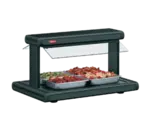
The Psychology of Restaurant Color Schemes
Creating a successful restaurant experience goes beyond delicious food and excellent service. The ambiance and overall atmosphere play a significant role in attracting and retaining customers. One crucial aspect of creating an inviting and memorable ambiance is the careful selection of restaurant color schemes. The psychology behind restaurant color schemes reveals that different colors can evoke specific emotions and influence customer behavior. By understanding the impact of colors and considering various factors, restaurant owners and designers can create a harmonious color palette that enhances the overall dining experience.
The Psychology of Colors

Colors have the power to elicit emotional responses and affect our perception of spaces. In the context of restaurant design, specific colors can create different moods and influence customer behavior. Let's explore the psychology behind some common colors used in restaurant interiors:
Red
The color red is associated with passion, energy, and excitement. It has the ability to stimulate appetite and create a sense of urgency, making it a popular choice for fast-food chains. However, it's important to use red sparingly, as an excessive amount can evoke feelings of restlessness and anxiety.
Blue
Blue is known for its calming and soothing effects. It can promote relaxation and reduce stress, making it suitable for restaurants aiming to create a tranquil atmosphere. Blue is also associated with cleanliness and professionalism, making it a common choice for seafood and fine dining establishments.
Yellow
Yellow is a vibrant and cheerful color that can create a warm and welcoming ambiance. It stimulates positivity and optimism, making it an excellent choice for casual and family-oriented restaurants. However, it's essential to use yellow as an accent color or in combination with other shades, as too much yellow can be overwhelming.
Green
Green is often associated with nature, freshness, and harmony. It has a calming effect and is ideal for restaurants that emphasize health-conscious or organic dining options. Green is commonly used in vegetarian and vegan restaurants, as it promotes a sense of well-being and environmental awareness.
Factors to Consider When Choosing Restaurant Color Schemes

When selecting a color scheme for your restaurant, it's essential to consider several factors that can influence the overall impact and success of your design. Here are the key factors to consider:
Target audience and brand identity
Understanding your target audience and aligning your color scheme with your brand identity is crucial. Consider the demographic and preferences of your customers. Are they young and trendy, or are they seeking a more sophisticated dining experience? The colors you choose should resonate with your target audience and reflect your brand identity. For example, a lively and vibrant restaurant may opt for bold and energetic colors, while an upscale establishment may lean towards classic and elegant tones.
Concept and theme of the restaurant
The concept and theme of your restaurant should guide your color choices. Consider the atmosphere and experience you want to create for your customers. If your restaurant has a rustic theme, warm earthy tones like browns and deep reds can evoke a cozy and inviting ambiance. On the other hand, a modern and minimalist concept may favor clean and neutral colors like white, gray, and black to create a sleek and contemporary atmosphere. Aligning your color scheme with your concept and theme helps create a cohesive and immersive dining experience.
Physical space and lighting conditions
The size, layout, and lighting conditions of your restaurant should also influence your color choices. Darker colors can make a space feel smaller and more intimate, which can be beneficial for cozy dining areas. Lighter colors, on the other hand, can create an illusion of spaciousness and make smaller spaces feel more open. Consider the natural and artificial lighting in your restaurant. Natural light can enhance certain colors, while artificial lighting can alter how colors appear. It's crucial to test how different colors interact with the lighting conditions in your space to achieve the desired effect.
Cultural and regional influences
Cultural and regional influences can play a significant role in color choices. Different cultures associate colors with various meanings and symbolism. For example, red is often associated with luck and prosperity in some Asian cultures, while white represents purity and cleanliness in many Western cultures. Research local preferences and customs to ensure your color scheme resonates with your target audience. Consider incorporating colors that align with the cultural context and traditions of your location to create a more meaningful and relatable dining experience.
The Impact of Restaurant Interior Colors on Customer Behavior

The chosen color scheme in a restaurant can have a significant impact on customer behavior and the overall dining experience. Here are a few ways in which color can influence customer behavior:
Reducing perceived waiting times
The strategic use of colors can help manage customers' perception of waiting times. Warm colors like red and orange are known to create a sense of urgency and make wait times feel shorter. These colors can stimulate a higher level of energy and activity, effectively distracting customers from the actual waiting time. As a result, customers may experience reduced feelings of impatience and increased satisfaction with the overall service.
Appetite stimulation and food presentation
Colors play a crucial role in stimulating appetite and influencing how food is perceived. Warm colors like red and yellow are associated with energy, excitement, and appetite stimulation. These colors can enhance the presentation of dishes, making them visually appealing and enticing to customers. Red, in particular, is known to increase heart rate and stimulate the senses, making it a popular choice for highlighting food items. On the other hand, cool colors like blue have a calming effect and can be used to suppress appetite, making them suitable for restaurants with a focus on portion control or healthier options.
Creating a relaxing and comfortable atmosphere
Colors like blue and green have a calming effect on individuals. These cool colors can create a relaxed and comfortable atmosphere in a restaurant. The use of blue and green hues can help reduce stress, promote a sense of tranquility, and encourage customers to spend more time in the establishment. This relaxed ambiance fosters a positive dining experience and may lead to customers feeling more at ease and satisfied with their visit.
Brand Perception and Customer Loyalty
Consistency in color schemes across branding materials and interior design is crucial for establishing a strong brand identity. When customers consistently associate specific colors with your restaurant, it can contribute to brand recognition and recall. By incorporating the same color scheme in your logo, signage, menus, and interior decor, you can create a cohesive and memorable visual experience. This consistency enhances brand perception, builds customer loyalty, and encourages repeat visits. When customers see the familiar colors associated with your restaurant, it triggers positive associations and reinforces their connection with your brand.
5 Restaurant Color Ideas

When it comes to selecting a color scheme for your restaurant, considering different themes and atmospheres can help you create a captivating and cohesive design. Here are five restaurant color ideas to inspire your design:
Rustic Elegance
Create a warm and inviting atmosphere with a rustic elegance color scheme. Incorporate warm earthy tones such as browns, deep reds, and burnt oranges. These colors evoke a sense of comfort and nostalgia, making them perfect for farm-to-table or traditional cuisine restaurants. The rich and earthy hues can be complemented by natural materials like wood and stone, enhancing the rustic aesthetic.
Modern Minimalism
For a sleek and contemporary ambiance, embrace a modern, minimalist color scheme. Opt for clean and neutral colors like white, gray, and black. These colors create a sense of simplicity and sophistication, allowing the focus to be on the food and overall dining experience. Accents of metallic or bold colors can add visual interest and contrast. This color scheme is popular in contemporary and fusion restaurants, where a clean and streamlined aesthetic is desired.
Coastal Vibes
If you want to evoke a sense of seaside charm, consider a coastal color scheme. Utilize shades of blue, turquoise, and sandy beige to create a coastal-themed atmosphere. These colors reflect the soothing tones of the ocean and beach, creating a relaxed and refreshing ambiance. Accents of white or natural wood can enhance the coastal feel. This color scheme is ideal for seafood or beachfront restaurants, where customers can immerse themselves in a coastal dining experience.
Bold and Vibrant
To infuse your restaurant with energy and liveliness, opt for a bold and vibrant color scheme. Embrace colors like reds, yellows, and oranges to create an energetic atmosphere. These vibrant hues stimulate the senses and create a lively ambiance. Incorporate these colors strategically as accents or focal points to avoid overwhelming the space. This color scheme suits casual and vibrant dining establishments, such as cafes, bistros, or family-oriented restaurants.
Classic Elegance
For an upscale and refined ambiance, consider a classic, elegant color scheme. Choose neutral colors like cream, beige, and soft gray to create a timeless and sophisticated atmosphere. These understated hues exude elegance and allow other design elements, such as high-quality materials and exquisite lighting fixtures, to take center stage. This color scheme is well-suited for upscale and fine-dining restaurants, where a luxurious and refined experience is desired.
To Wrap Up!
In conclusion, the color scheme in a restaurant significantly impacts the dining experience and customer behavior. Considering factors such as the target audience, concept and theme, physical space, and cultural influences allows restaurant owners and designers to create a visually appealing and cohesive ambiance that aligns with their brand identity. By strategically selecting colors that stimulate appetite, create a relaxing atmosphere, and reinforce brand recognition, restaurants can enhance customer satisfaction and leave a lasting impression. Additionally, optimizing the visual impact by considering the physical space and lighting conditions contributes to a successful color scheme. Taking these factors into account ensures that the color scheme enhances the overall dining experience and creates a memorable atmosphere.
If you're looking for more insights and inspiration for restaurant design, interior decorating, and increasing your restaurant's success, we invite you to explore other articles on CKitchen. Visit CKitchen's blog today to dive deeper into the world of restaurant management and design.
Remember, choosing the right color scheme is just one step towards creating an exceptional dining experience. Combine it with thoughtful menu planning, effective marketing strategies, and top-notch service to truly set your restaurant apart. We wish you all the best in creating a vibrant and successful establishment.
FAQ
What are the best colors for restaurants?
The best colors for restaurants depend on the desired atmosphere and target audience. Warm colors like red and yellow can stimulate the appetite, while cool colors like blue and green create a more relaxed ambiance. Ultimately, the colors should align with the restaurant's concept and brand identity.
What color is relaxing for a restaurant?
Blue is commonly associated with relaxation and calmness. It can create a soothing atmosphere in a restaurant, making it an ideal choice for those aiming to provide a tranquil dining experience.
What colors are avoided in restaurants?
While personal preferences may vary, some colors are generally avoided in restaurants. For example, overly bright or garish colors can be overwhelming and distract from the dining experience. Additionally, too much black can create a gloomy ambiance.
How can color impact your restaurant?
Colors can impact your restaurant in various ways. They can influence customer behavior, such as appetite stimulation, perception of waiting times, and overall comfort. Colors also contribute to creating a brand identity and promoting customer loyalty.
Why is color important in a restaurant?
Color is important in a restaurant because it helps create the desired ambiance, influences customer perception, and contributes to the overall dining experience. The right color scheme can attract customers, enhance food presentation, and reinforce the restaurant's brand image.



